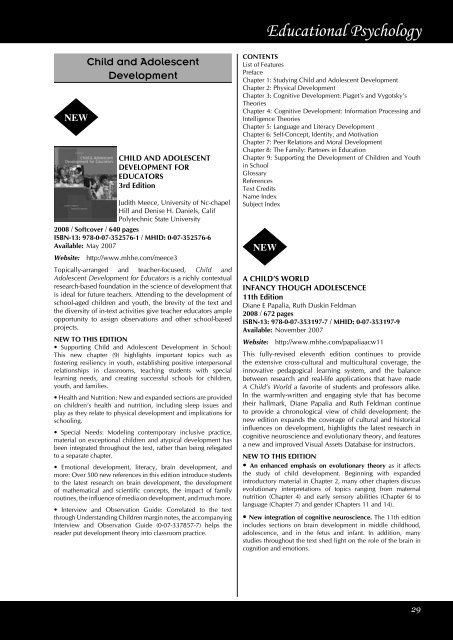table of contents - McGraw-Hill Books
table of contents - McGraw-Hill Books
table of contents - McGraw-Hill Books
Create successful ePaper yourself
Turn your PDF publications into a flip-book with our unique Google optimized e-Paper software.
Educational Psychology<br />
NEW<br />
Child and Adolescent<br />
Development<br />
CHILD AND ADOLESCENT<br />
DEVELOPMENT FOR<br />
EDUCATORS<br />
3rd Edition<br />
Judith Meece, University <strong>of</strong> Nc-chapel<br />
<strong>Hill</strong> and Denise H. Daniels, Calif<br />
Polytechnic State University<br />
2008 / S<strong>of</strong>tcover / 640 pages<br />
ISBN-13: 978-0-07-352576-1 / MHID: 0-07-352576-6<br />
Available: May 2007<br />
Website: http://www.mhhe.com/meece3<br />
Topically-arranged and teacher-focused, Child and<br />
Adolescent Development for Educators is a richly contextual<br />
research-based foundation in the science <strong>of</strong> development that<br />
is ideal for future teachers. Attending to the development <strong>of</strong><br />
school-aged children and youth, the brevity <strong>of</strong> the text and<br />
the diversity <strong>of</strong> in-text activities give teacher educators ample<br />
opportunity to assign observations and other school-based<br />
projects.<br />
NEW TO THIS EDITION<br />
• Supporting Child and Adolescent Development in School:<br />
This new chapter (9) highlights important topics such as<br />
fostering resiliency in youth, establishing positive interpersonal<br />
relationships in classrooms, teaching students with special<br />
learning needs, and creating successful schools for children,<br />
youth, and families.<br />
• Health and Nutrition: New and expanded sections are provided<br />
on children’s health and nutrition, including sleep issues and<br />
play as they relate to physical development and implications for<br />
schooling.<br />
• Special Needs: Modeling contemporary inclusive practice,<br />
material on exceptional children and atypical development has<br />
been integrated throughout the text, rather than being relegated<br />
to a separate chapter.<br />
• Emotional development, literacy, brain development, and<br />
more: Over 500 new references in this edition introduce students<br />
to the latest research on brain development, the development<br />
<strong>of</strong> mathematical and scientific concepts, the impact <strong>of</strong> family<br />
routines, the influence <strong>of</strong> media on development, and much more.<br />
• Interview and Observation Guide: Correlated to the text<br />
through Understanding Children margin notes, the accompanying<br />
Interview and Observation Guide (0-07-337857-7) helps the<br />
reader put development theory into classroom practice.<br />
CONTENTS<br />
List <strong>of</strong> Features<br />
Preface<br />
Chapter 1: Studying Child and Adolescent Development<br />
Chapter 2: Physical Development<br />
Chapter 3: Cognitive Development: Piaget’s and Vygotsky’s<br />
Theories<br />
Chapter 4: Cognitive Development: Information Processing and<br />
Intelligence Theories<br />
Chapter 5: Language and Literacy Development<br />
Chapter 6: Self-Concept, Identity, and Motivation<br />
Chapter 7: Peer Relations and Moral Development<br />
Chapter 8: The Family: Partners in Education<br />
Chapter 9: Supporting the Development <strong>of</strong> Children and Youth<br />
in School<br />
Glossary<br />
References<br />
Text Credits<br />
Name Index<br />
Subject Index<br />
NEW<br />
A CHILD’S WORLD<br />
INFANCY THOUGH ADOLESCENCE<br />
11th Edition<br />
Diane E Papalia, Ruth Duskin Feldman<br />
2008 / 672 pages<br />
ISBN-13: 978-0-07-353197-7 / MHID: 0-07-353197-9<br />
Available: November 2007<br />
Website: http://www.mhhe.com/papaliaacw11<br />
This fully-revised eleventh edition continues to provide<br />
the extensive cross-cultural and multicultural coverage, the<br />
innovative pedagogical learning system, and the balance<br />
between research and real-life applications that have made<br />
A Child’s World a favorite <strong>of</strong> students and pr<strong>of</strong>essors alike.<br />
In the warmly-written and engaging style that has become<br />
their hallmark, Diane Papalia and Ruth Feldman continue<br />
to provide a chronological view <strong>of</strong> child development; the<br />
new edition expands the coverage <strong>of</strong> cultural and historical<br />
influences on development, highlights the latest research in<br />
cognitive neuroscience and evolutionary theory, and features<br />
a new and improved Visual Assets Database for instructors.<br />
NEW TO THIS EDITION<br />
• An enhanced emphasis on evolutionary theory as it affects<br />
the study <strong>of</strong> child development. Beginning with expanded<br />
introductory material in Chapter 2, many other chapters discuss<br />
evolutionary interpretations <strong>of</strong> topics ranging from maternal<br />
nutrition (Chapter 4) and early sensory abilities (Chapter 6) to<br />
language (Chapter 7) and gender (Chapters 11 and 14).<br />
• New integration <strong>of</strong> cognitive neuroscience. The 11th edition<br />
includes sections on brain development in middle childhood,<br />
adolescence, and in the fetus and infant. In addition, many<br />
studies throughout the text shed light on the role <strong>of</strong> the brain in<br />
cognition and emotions.<br />
29

















